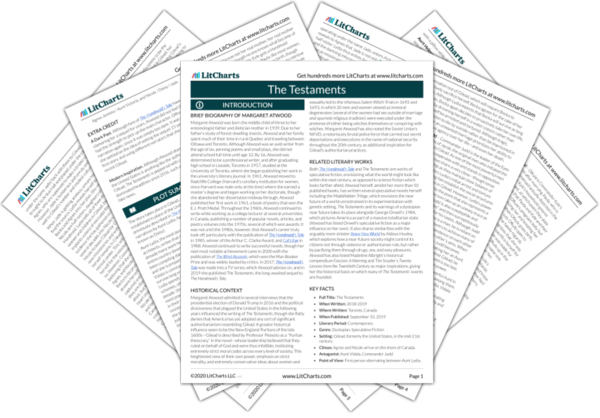Welcome to the LitCharts study guide on Margaret Atwood's The Testaments. Created by the original team behind SparkNotes, LitCharts are the world's best literature guides.
The Testaments: Introduction
The Testaments: Plot Summary
The Testaments: Detailed Summary & Analysis
The Testaments: Themes
The Testaments: Quotes
The Testaments: Characters
The Testaments: Terms
The Testaments: Symbols
The Testaments: Literary Devices
The Testaments: Theme Wheel
Brief Biography of Margaret Atwood

Historical Context of The Testaments
Other Books Related to The Testaments
Key Facts about The Testaments
- Full Title: The Testaments
- When Written: 2018-2019
- Where Written: Toronto, Canada
- When Published: September 10, 2019
- Literary Period: Contemporary
- Genre: Dystopian, Speculative Fiction
- Setting: Gilead, formerly the United States, in the mid-21st century
- Climax: Agnes and Nicole arrive on the shore of Canada.
- Antagonist: Aunt Vidala, Commander Judd
- Point of View: First person alternating between Aunt Lydia, Agnes Jemima / Aunt Victoria, and Nicole / Daisy / Jade
Extra Credit for The Testaments
A Dark Past. Although fans of The Handmaid’s Tale have been clamoring for a sequel for years, Atwood did not feel like she had the strength to pick up the main character, Offred’s, narration again, since it was simply too dark. It was only once she settled on the idea of setting the sequel 15 years after the first story and using different narrators that she was able to revisit Gilead.
Modern Inspiration. Although Atwood does not believe that the United States is anything like the authoritarian state of Gilead, The Testaments is peppered with concepts that have dominated headlines since 2016, such as climate change and fake news.







